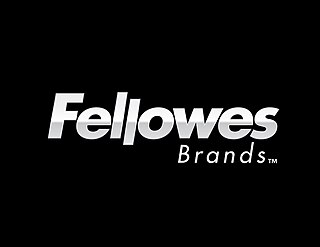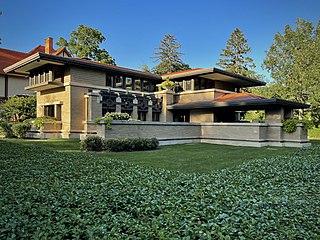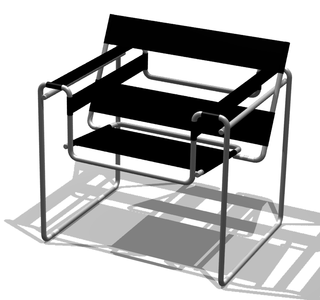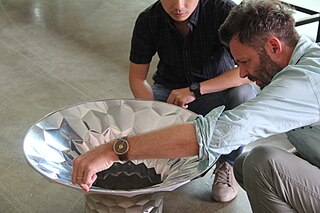IDEO is a design and consulting firm with offices in the U.S., England, and China. It was founded in Palo Alto, California, in 1991. The company's 500 staff uses a design thinking approach to design products, services, environments, brands, and digital experiences.

A desk or bureau is a piece of furniture with a flat table-style work surface used in a school, office, home or the like for academic, professional or domestic activities such as reading, writing, or using equipment such as a computer. Desks often have one or more drawers, compartments, or pigeonholes to store items such as office supplies and papers. Desks are usually made of wood or metal, although materials such as glass are sometimes seen.

A cubicle is a partially enclosed office workspace that is separated from neighboring workspaces by partitions that are usually 5–6 feet (1.5–1.8 m) tall. Its purpose is to isolate office workers and managers from the sights and noises of an open workspace so that they may concentrate with fewer distractions. Cubicles are composed of modular elements such as walls, work surfaces, overhead bins, drawers, and shelving, which can be configured depending on the user's needs. Installation is generally performed by trained personnel, although some cubicles allow configuration changes to be performed by users without specific training.

An office is a space where the employees of an organization perform administrative work in order to support and realize the various goals of the organization. The word "office" may also denote a position within an organization with specific duties attached to it ; the latter is an earlier usage, office as place originally referring to the location of one's duty. In the adjective form, the term "office" may refer to business-related tasks. In law, a company or organization has offices in any place where it has an official presence, even if that presence consists of a storage silo, for example, instead of a more traditional establishment with a desk and chair. An office is also an architectural and design phenomenon, including small offices, such as a bench in the corner of a small business or a room in someone's home, entire floors of buildings, and massive buildings dedicated entirely to one company. In modern terms, an office is usually the location where white-collar workers carry out their functions.
Haworth Inc. is a privately held, family-owned office furniture manufacturer headquartered in Holland, Michigan, United States. Founded in 1948 by G. W. Haworth, the company designs and manufactures seating, tables, movable walls, panels, storage, and wood casegoods. Haworth's furniture pieces, combined with interior design and technology, are intended to create a focus on “organic workspaces that help people perform their best.” Haworth employs 7,500 workers and has 650 dealerships in more than 120 countries. 2021 global sales reached $1.96 billion, a 6.2-percent increase from 2020.

Fellowes Brands, Inc. is a privately held manufacturer of office equipment based in Itasca, Illinois. The company was founded as the Bankers Box Company to manufacture the company's namesake Bankers Box record storage boxes. Since the 1960s, the company has diversified its portfolio of products, changing its name to Fellowes and becoming a market leader of paper shredders and record storage products in the United States.

The Meyer May House is a Frank Lloyd Wright-designed house in the Heritage Hill Historic District of Grand Rapids, Michigan, in the United States. It was built in 1908–09, and is located at 450 Madison Avenue SE. It is considered a fine example of Wright's Prairie School era, and "Michigan's Prairie masterpiece".

Knoll is an American company that manufactures office systems, seating, storage systems, tables, desks, textiles, and accessories for the home, office, and higher education. The company is the licensed manufacturer of furniture designed by architects and designers such as Harry Bertoia, Ludwig Mies van der Rohe, Florence Knoll, Frank Gehry, Charles Gwathmey, Maya Lin, Marcel Breuer, Eero Saarinen, and Lella and Massimo Vignelli, under the company's KnollStudio division. Over 40 Knoll designs can be found in the permanent design collection of the Museum of Modern Art in New York City.

A Hoosier cabinet or Hoosier is a type of cupboard or free-standing kitchen cabinet that also serves as a workstation. It was popular in the first few decades of the 20th century in the United States, since most houses did not have built-in kitchen cabinetry. The Hoosier Manufacturing Co. of New Castle, Indiana, was one of the earliest and largest manufacturers of this product, causing the term "Hoosier cabinet" to become a generic term for that type of furniture. By 1920, the Hoosier Manufacturing Company had sold two million cabinets.

The Metal Office Furniture Company (Steelcase) Plants No. 2 and 3 are historic manufacturing plants located at 401 Hall Street SW in Grand Rapids, Michigan.

Grand Rapids is a city and county seat of Kent County in the U.S. state of Michigan. At the 2020 census, the city had a population of 198,893 which ranks it as the second most-populated city in the state after Detroit. Grand Rapids is the central city of the Grand Rapids metropolitan area, which has a population of 1,087,592 and a combined statistical area population of 1,383,918.
Carl Gustav Magnusson is an industrial designer, inventor, design juror and lecturer.

Michael Young is a British industrial designer and creative director based in Hong Kong. He works in the areas of product, furniture and interior design with studios in Hong Kong and Brussels. He is known for unconventional use of materials and manufacturing processes, and collaborations with brands such as Brionvega, Cappellini, KEF, La Manufacture, and MOKE International. He is interested in "how disruption in society always has a design response, because it usually creates a need for things that perform."
The Pace Collection was a high-end contemporary furniture company in business from 1960 to 2001. The company was founded by Irving and Leon Rosen in New York City. The showroom was located in Manhattan on East 62nd Street to offer its fine furniture and services to the contract interior design trade. The Pace Collection advertised in numerous architectural and interior design periodicals. The Pace Collection furniture designs were all distinctly different from those offered by Knoll (company), Herman Miller, Steelcase and other contract furniture companies.
Coalesse is a United States–based furniture company founded in 2008. It is a division of Steelcase and creates products with the goal of encouraging collaboration. Coalesse is headquartered in Grand Rapids, Michigan, with their design headquarters in San Francisco and their main showroom located in the Merchandise Mart in Chicago.
Polyvision is a company that manufactures CeramicSteel surfaces for applications such as whiteboards, chalkboards, architectural surfaces and panels, and infrastructure projects. Headquartered in Georgia, Polyvision was acquired by Industrial Opportunity Partners in February 2020. The company was founded in 1954 under the name Information Display Technology, Inc. and began operating under the name Polyvision in May 1995. Polyvision has production facilities in Okmulgee, Oklahoma, New Philadelphia, Ohio, and Genk, Belgium, with their Okmulgee facility being one of the area's major employers.
Turnstone is an office furniture company based in Grand Rapids, Michigan. It is a division of Steelcase and was founded in 1993. The brand was created with the intention of reaching younger businesses with budgets too small to afford a dedicated facilities manager and offices with a small number of in-office employees. As of January 2006, the company employed 30 people.

The Hoover desk, also known colloquially as FDR's Oval Office desk, is a large block front desk, used by Presidents Herbert Hoover and Franklin D. Roosevelt in the Oval Office. Created in 1930 as a part of a 17-piece office suite by furniture makers from Grand Rapids, Michigan, the Art Deco desk was given to the White House by the Grand Rapids Furniture Manufacturers Association during the Hoover administration. The desk was designed by J. Stuart Clingman, and was built by the Robert W. Irwin Company from American lumber and faced with Michigan-grown maple burl wood veneer. After Roosevelt's sudden death in 1945, Harry S. Truman removed the desk from the Oval Office and gave it to Roosevelt's wife, Eleanor Roosevelt. She displayed it at, and later donated it to, the Franklin D. Roosevelt Presidential Library and Museum in Hyde Park, New York. The desk has been on display there ever since. The Hoover desk is one of only six desks to be used by a president in the Oval Office.

James Patrick Hackett is an American businessman. He was the president and chief executive officer of Ford Motor Company from May 2017 to October 2020.

Fast Radius is a company that provides manufacturing services in four main areas: application discovery, product design and testing, production-grade manufacturing, and global fulfillment. Its on-demand manufacturing capabilities include additive manufacturing, or 3D printing, CNC machining, injection molding, and urethane casting.



















